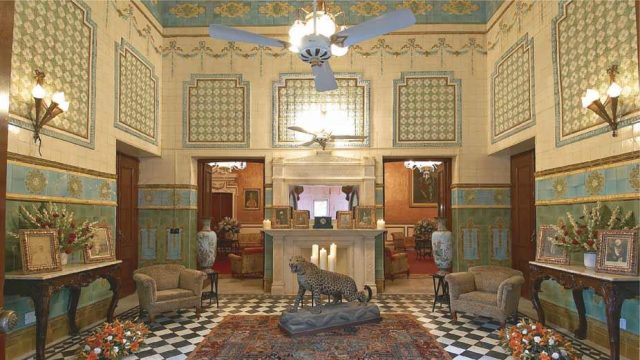We drive up through great wrought-iron gates, down a tree-lined gravel path and stop in front of a vast European edifice: the Raj Niwas Palace in Dholpur, Rajasthan. Built by the ruler of Dholpur, the palace is owned by Dushyant Singh, son of Vasundhara Raje who married into the royal family. Even before I step inside, the subtle application of local craftsmanship on the red-stone is evident — intricate arabesques and jaalis cover the façade.
The dusty five-hour drive from Delhi has got me obsessing about a shower. I fail to pay attention to the Maharaja Suite where I am to spend the night, as I am ushered into its bathroom. The bathroom walls are clad from floor to ceiling with a variety of startling blue, fantastically patterned ceramic tiles. Then my eyes fall on the piéce de rèsistance: an ancient ceramic bathtub fitted with a network of water jets, like a Jacuzzi, more than a century old. The words ‘Douche’, ‘Wave’, ‘Spray’, ‘Shower’, ‘Plunge’, and ‘Jet’ are printed on the shiny taps. I feel compelled to postpone my shower and investigate this wonderful, quirky contraption manufactured by Doulton and Co of London. Incredibly, it works!
This, I realise, as I wander from room to room, is what is marvellous about Raj Niwas Palace. Art Nouveau-style light fittings, elaborate tower bolts, gorgeous heaters, Swiss-made Piccolo Bells (“made expressly for Simla in 1891 by Metert and Co., Geneva”), the grandfather clock (Hamilton and Co, Calcutta) and the giant pedestal fans (Chicago Radio Co) are all carefully preserved. Someone here has loved this place and its things a lot. But it’s incredible that no one — not the owner, not the manager — seems to know the year it was constructed (but apparently it was built to welcome HRH Albert Edward, the Prince of Wales, when he visited in 1876).
I am now prepared to be overwhelmed by the room. The Maharaja Suite is not only large enough to cause exhaustion simply walking from bed to wardrobe, but every square inch is covered with ceramic tiles with a fish-and-water motif, glazed in cobalts and ochres. The floor is a mosaic of coloured oxide tiles, the plasterwork on the ceiling is gilded. Other rooms too are richly decorated with tiles.
I step out to catch my breath. The sprawling grounds remind Calcuttan me of the Victoria Memorial — cast iron lamps and a small pool embellish the greens. After a comforting North Indian lunch I am escorted around Dholpur town by a member of the palace staff (all old retainers, they are a most pleasant and affable lot). Dholpur is a little heritage town — apart from an ancient complex of temples, a step well and the ruins of Shergarh, many little gems from the past are to be found tucked away. Me, I’ve just enjoyed the sparkling jewel in the crown.
The information
Location: Dholpur, 40km south of Agra, about 287km from Delhi
Accommodation: Eight suites
Tariff: Rs 9,000 for double occupancy
Contact: +91-7665002151, http://dholpurpalace.com/rooms&villas.php




